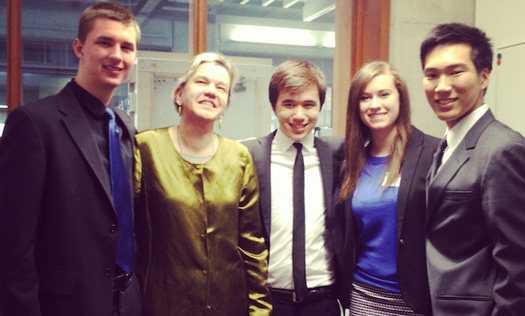What color am I wearing?
by Beth
People stare at my Seeing Eye dog and me sometimes. Who can blame them? We’re an unusual pair! But as long as they’re watching, I want to look good.
So when I heard that the Segal Design Institute at Northwestern University was looking for projects to help people with disabilities, I suggested they have their freshmen engineering students try to come up with some easy way we blind folks could keep track of the color of our clothing. Right now I put a safety pin in the tag of anything I own that is black, and a paper clip on anything white. I wear other colors, too, and I memorize what color those other things are by the feel of the clothing.
My proposal got a thumbs-up, and after my Seeing Eye dog Whitney and I visited Northwestern to explain what I needed, one engineering class there divided into four different groups to tackle my problem. They visited our apartment a couple of times to take a look at the way I arrange my clothing now and to ask questions that would help with their research. Freshmen in other Design Thinking and Communication class sections were working on other projects for people with disabilities at the same time. Here are some examples
- A man who uses a wheelchair wanted an easier way to fold up the footrests when it came to transferring into a car or a regular chair
- A man with cerebral palsy was looking for a more efficient way to pull his trousers up on his own
- Occupational therapists asked for a device that might encourage their clients with Parkinson’s disease to do finger exercises on-the-go
- The Rehabilitation Institute of Chicago hoped a class could figure out a way for clients with visual impairments to know how fast (and at what speed) they were walking on exercise treadmills
- a woman who uses a wheelchair and enjoys outdoor concerts was looking for a way to slide from her chair onto the lawn, then get back into her chair again on her own when the concert was over.
Whitney and I traveled to a Design Expo at Northwestern to hear all of the students present their completed projects. When the students working on my color identification challenge had visited our apartment in February with prototypes, they ranged from carabiners to iron-on tags to QR codes that my talking iPhone could read to me. Seeing (okay, touching) what these four teams had come up with in the end made me glad I’d come out of the closet about my wardrobe woes! All four teams had expanded on my tried and true safety-pin method, each team inventing different things to hang from the pin to correspond to the color of the item.
The “Fantagstic!” team came up with acrylic shapes on cloth tags. They reasoned that cloth tags would be lightweight, so I could use two or more at a time to identify multi-colored items. The tags another team came up with were laser-cut acrylic shapes called “Depindables.” The “Code of Many Colors” team used small glass beads on the safety pin: one bead means black, two beads mean white, and so on. “Tag Team” was the only team to use traditional Braille code on its tags — the other teams learned from research that a majority of people who are visually impaired do not read Braille. The tags that all four teams came up with had all been tested to withstand high temperatures in the washer and dryer.
Judges from engineering firms were on hand to decide on winners for each proposal, and the winner for mine was … drumroll, please … Tag Team!

The Tag Team system is more than a label to safety-pin onto my clothes. It’s also a way to organize my closet and laundry. Tag Team includes a laundry hamper that holds a number of mesh bags, each bag with a tag attached that corresponds with a single color. They figure doing laundry will be easier if I don’t mix all my clothing in the hamper, only to have to resort it all again when the wash cycle is over. “All you do is put your clothes in the bag it belongs in, take the bag out, tighten the string, and throw the bag in the washing machine.”
I had to hand it to ‘em. But if you ask me, all the teams at the design expo were winners. These kids are just freshmen, and not only have they learned about design process, but also how much it can mean to work together to help people with unusual, unique, and unmet needs. I was the biggest winner of all, though: I got to work side-by-side with these talented and thoughtful young people, and when design expo was over, I walked out with custom-made prototypes of all the tags!
Folks I talked to from the Segal Design Institute at Northwestern University told me they’re always looking for new project proposals from people with disabilities and organizations who work with us. If there’s something you need and you live in the Chicago area, submit a proposal soon. If you don’t live near Chicago, I strongly suggest you encourage a college near you to start a similar program. Working with this one at Northwestern was, well … fantagstic!






